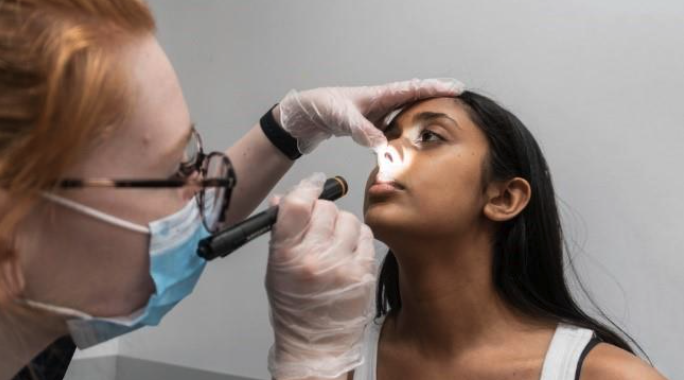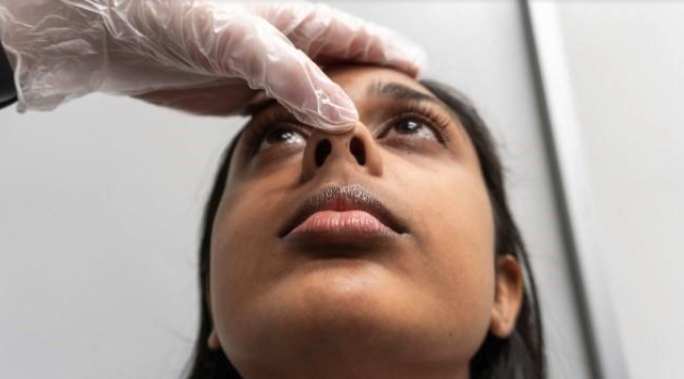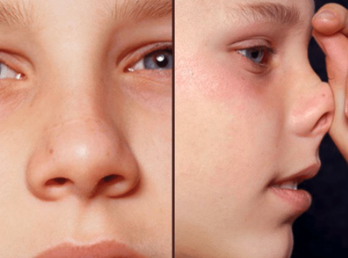* Approved by CPG Committee; PIC endorsement pending
See also
Antimicrobial guidelines
Periorbital and orbital cellulitis
Asthma
Key points
- Infective rhinosinusitis rarely leads to orbital or intracranial complications
- Allergic rhinitis should be managed with allergen minimisation, antihistamines +/- nasal steroids
- Neonatal rhinitis is common and often resolves without treatment
Background
- Rhinitis and rhinosinusitis are characterised by inflammation of the nasal mucosa and paranasal sinuses, respectively (often co-exist)
- Rhinitis is classified as allergic (perennial or seasonal) or non-allergic
- Rhinosinusitis is classified as
- Acute:
<4 weeks (usually infectious)
- Recurrent acute: At least 3 acute episodes with at least 10 days or more with no symptoms in 6 months, or at least 4 episodes in 12 months
- Subacute: 4-12 weeks
- Chronic: >12 weeks
Acute rhinosinusitis is most commonly caused by viral infections, but secondary acute bacterial rhinosinusitis may develop, particularly if symptoms persist beyond 10 days
- Viral: Rhinovirus, RSV, influenza, adenovirus, additional systemic symptoms of viral illness common
- Bacterial: Streptococcus pneumoniae, Haemophilus influenzae (non-typeable), Moraxella catarrhalis
Allergic rhinitis is the most common form of rhinitis and is associated with an IgE-mediated response to environmental allergens (seasonal or perennial)
- Classic symptoms include persistent sneezing, watery nasal discharge, itching, and nasal congestion. Ocular symptoms (eg itchy, watery, red eyes) are also common
- Significant implications for childhood asthma
- A risk factor for the development of asthma
- Affects asthma control
- Impacts the prognosis and progression of asthma into adulthood
Neonatal rhinitis or nasal congestion in newborns is common and often resolves without treatment
Assessment
Examination
Examine the nasal mucosa
- Use the 'pig nose' manoeuvre to examine the nasal mucosa (tilt child's head back, elevate the nasal tip with your thumb, and illuminate the orifice with light/otoscope)


- Examine mucosal surfaces, colour and calibre of turbinates, and position of septum
- Pale, boggy mucosa of inferior turbinates is in keeping with allergic rhinitis
- Red and oedematous mucosa is seen more commonly in infective or medication induced rhinitis
Assessment by cause
Acute bacterial sinusitis
| History |
Examination |
Complications |
- Preceding viral illness is common
- Persistent nasal discharge >10 days (purulence is of little significance)
- Nasal obstruction
- Maxillary toothache
- Unilateral facial pain
- Headache
- Fever
|
- Inflamed nasal mucosa
- Signs of acute otitis media are commonly seen, reflecting a shared aetiology
|
|
Chronic rhinosinusitis
| History |
Risk factors |
|
Uncommon
<12 years
Symptoms occur for 12 weeks or more
- Nasal obstruction/congestion
- Nasal discharge
- Facial pain
- Postnasal drip
- Loss of smell
- Cough
- Halitosis
|
- Exposure to cigarette smoke
- Adenoid hypertrophy
- Allergy
- Asthma
- Reflux disease
- Cystic fibrosis
- Physical obstruction
- Mucociliary impairment
- Immune deficiency
- Prolonged use of intranasal decongestants
|
Allergic rhinitis
| History |
Risk factors |
- Sneezing, itchy nose, sniffing, upward rubbing of the nose
- Nasal obstruction/congestion eg nasal speech, mouth breathing, snoring
- Itchy throat, frequent need to clear the throat
- Triggers eg season, pollen, household dust, moulds, mites, animals
- Seasonal (spring/summer with increased pollen counts), Perennial (persistent symptoms, discharge usually clear, paroxysmal sneezing common)
- Comorbidities such as asthma, allergic conjunctivitis or eczema
- Family history of atopy
|
- Allergic facies (Dennie-Morgan lines, allergic salute, allergic shiners, transverse nasal crease and mouth breathing)
- Clear rhinorrhoea
- Watery, itchy eyes (in allergic conjunctivitis)
- Pale, boggy mucosa of inferior turbinates

|
Other causes
| Category |
Description |
| Obstructive |
Foreign body: Unilateral symptoms, brown discharge, foreign body may be visible, foul odour common from the affected nostril
Adenoidal hypertrophy: Mouth breathing and snoring may be present |
| Hormonal |
Association with menstrual cycle, pregnancy
Subclinical hypothyroidism in older children |
| Drug induced |
Typically aspirin and other NSAIDS
Consider 'rebound congestion' (inflammation of the nasal mucosa caused by overuse of topical nasal decongestants) if history suggestive |
| Environmental irritants |
Cigarette smoke, environmental pollutants |
| Granulomatous diseases |
External nasal swelling, sinusitis, nose bleeds |
| Idiopathic/vasomotor rhinitis |
Sudden onset and offset of watery nasal discharge. Can be triggered by strong smells or changes in environmental temperature |
| If recurrent or severe, consider rarer causes |
- Anatomical anomalies
- Immunodeficiency
- Ciliary dysfunction
- Cystic fibrosis
|
Assessment of severity
Allergic rhinitis may be classified by symptoms
- Duration
- Intermittent: Symptoms occur
<4 days/week or <4 weeks
- Persistent: Symptoms occur >4 days/week and for >4 weeks
- Severity
- Mild: Normal sleep, no impairment of daily activities, normal work or school performance
- Moderate-severe: One or more of sleep disturbance, daytime tiredness affecting work, school or other activities, symptoms affecting quality of life
Management
Investigations
In most instances the diagnosis is made clinically and no investigations are required
Acute rhinosinusitis
- Nasal swabs should not be taken. Culture is not indicative of sinus pathogens and is therefore not helpful
- CT is the imaging modality of choice, consider if
- Failed medical management
- Possible orbital or intracranial complication
- Surgery is being considered
Allergic rhinitis
- Further testing is not diagnostic and needs to be correlated with clinical history. Positive results only confirm sensitisation to allergens
- Testing may assist with allergen minimisation
- Serum specific IgE (previously known as RAST) to environmental allergens. Not affected by anti-allergy medications
- Skin prick testing. Affected by anti-allergy medications
Treatment
Neonatal rhinitis
- Nasal antihistamines, decongestants, steroids and humidifiers are not recommended
- Saline drops can be used prior to feeding
- Specialist review if impacting breathing or feeding
Acute rhinosinusitis
- Consider watchful waiting for 3 days to assess for spontaneous resolution as acute viral sinusitis is the most likely cause with similar signs and symptoms
- Antibiotics can be commenced if there is no improvement at this time or if there is clinical worsening
- Antimicrobial recommendations may vary according to local antimicrobial susceptibility patterns; please refer to local guidelines
Acute bacterial sinusitis
| Treatment Category |
Recommendation |
| 1st line |
Amoxicillin 15 mg/kg (max 500 mg) oral tds for 5 days
(Cefalexin if penicillin allergy)
If not improving,
Amoxicillin/clavulanic acid 22.5 mg/kg (max 875 mg) oral 12 hourly for another 5 days |
| Systemically unwell or unable to tolerate oral |
Amoxicillin/clavulanic acid 25 mg/kg (max 1 g) IV 6 hourly
(Ceftriaxone and metronidazole if penicillin allergy) |
| Orbital or intracranial complications |
Local antimicrobial guidelines |
Additional treatments
- Steroid sprays, decongestants, or antihistamines has been shown to have no benefit in acute sinusitis
- Surgery is very rarely needed for acute bacterial sinusitis (in the absence of orbital or intracranial complications)
Chronic rhinosinusitis
- Intranasal saline spray or irrigation for minimum 6 weeks
- Sodium chloride, 2 sprays or irrigations into each nostril twice daily and as required
- Use prior to steroid spray
- Intranasal corticosteroid for minimum 6 weeks
- Eg mometasone 50 microg nasal spray
- 2-12 years, 1 spray into each nostril daily
- 12-18 years, 2 sprays into each nostril daily. Reduce to 1 spray into each nostril daily when symptoms controlled
- To be used in conjunction with allergen minimisation
- Assess treatment adherence and nasal spray technique
- There is no role for oral or intranasal decongestants
- There are many different brands of pharmacotherapy treatments available with varying cost and accessibility (over the counter or script)
- Referral to ENT is recommended if the above are unsuccessful in relieving symptoms
- Surgery may be considered
Allergic rhinitis
Pharmacotherapy
- To be used in conjunction with allergen minimisation for common allergens eg house dust mite, pollens, pet dander and mould
- Trial each step for around 4 weeks before assessing response
- Assess treatment adherence and nasal spray technique before escalating
- Use minimal effective regimen
- There is no role for oral or intranasal decongestants
- There are many different brands of pharmacotherapy treatments available with varying cost and accessibility (over the counter or script)
Mild Symptoms
Step 1: Oral antihistamine OR intranasal antihistamine
- Using both is not of additional benefit
- Can be used as required for intermittent symptoms or regularly for persistent symptoms
| Oral antihistamine |
Intranasal antihistamine |
- More effective than intranasal for symptoms such as itch at non nasal sites
- Typically better tolerated in younger children
- Less sedating antihistamines recommended
- Eg cetirizine
- 1-2 years, oral drops, 2.5 mg (5 drops) twice daily
- 2-6 years, oral 5 mg once daily or 2.5 mg twice daily
- 6-12 years, oral 10 mg once daily or 5 mg twice daily
- 12-18 years, oral 10 mg
|
- More effective than oral for local nasal symptoms
- Faster onset of action
- Require good technique
- Eg azelastine (1mg/mL nasal spray)
- >5 years, 1 spray into each nostril twice daily
|
Moderate to Severe Symptoms
Step 2: Add intranasal corticosteroid
- Especially effective for nasal obstruction and reduces ocular symptoms
- Require good technique and adherence to be effective
- Symptom relief usually starts within a few days but a minimum trial of 4 weeks of consistent use is required to establish efficacy
- Eg mometasone 50 microg nasal spray
- 2-12 years, 1 spray into each nostril daily
- 12-18 years, 2 sprays into each nostril daily. Reduce to 1 spray into each nostril daily when symptoms controlled
Step 3: Consider change to combination intranasal antihistamine and corticosteroid if predominant nasal symptoms
- Cease any oral antihistamine if taking
- Eg azelastine with fluticasone propionate 125/50 microg nasal spray
- 6-18 years, 1 spray into each nostril twice daily
Step 4: Add site specific pharmacotherapy for persisting symptoms
- Ocular symptoms: add eye drops
- Ketotifen 0.025% eye drops - 3-18 years, 1 eye drop twice daily
- Prophylaxis against recurrent ocular flares
- Olopatadine 0.1% eye drops - 3-18 years, 1 eye drop twice daily up to 14 weeks
- Intermittent allergic rhinitis and co-existing asthma, consider adding montelukast
Allergen Immunotherapy
- For moderate to severe symptoms not responding to treatment (including allergen minimisation)
- Referral to immunology/allergy specialist
- Subcutaneous (SCIT) or sublingual (SLIT) for at least 3 years
- Not covered by PBS and there may be a significant yearly cost
Consider consultation with local paediatric team when
- All systemically unwell children
- Suspected orbital or intracranial complication
Consider referral to an ENT specialist when
- Suppurative complications are present, or surgical intervention may be required
- Medically refractory nasal obstruction
- Symptoms persist or fail to resolve with recommended management
Consider referral to a clinical immunology/allergy specialist when
- Further allergy testing and interpretation is required to facilitate allergen minimisation
- Severe or inadequately controlled allergic rhinitis despite treatment
- Consideration for allergen immunotherapy
Consider transfer when
- Suspected intracranial involvement with altered conscious state, seizures or focal neurological signs
- Child requiring escalation of care beyond local centre
For emergency advice and paediatric or neonatal ICU transfers, see Retrieval Services
Consider discharge when
- In children with acute bacterial sinusitis, who were systemically unwell after 1-2 days of IV antibiotics and able to tolerate oral antibiotics
- Most children with other causes of rhinitis and rhinosinusitis do not need admission
Parent information
Sinusitis
Allergic rhinitis (hay fever) and sinusitis
Allergic rhinitis (hay fever)
Allergen minimisation
How to use a nasal spray
Additional notes
Allergic rhinitis treatment plan
*Last updated October 2025
Reference List
- Allergy & Anaphylaxis Australia. Chronic rhinosinusitis. https://allergyfacts.org.au/__interest/sinusitis (viewed February 2025)
- Australasian Society of Clinical Immunology and Allergy. Allergic Rhinitis (Hay Fever) and Sinusitis. https://www.allergy.org.au/patients/allergic-rhinitis-hay-fever-and-sinusitis (viewed February 2025)
- Australasian Society of Clinical Immunology and Allergy. Non-Allergic Rhinitis. https://www.allergy.org.au/patients/allergic-rhinitis-hay-fever-and-sinusitis/non-allergic-rhinitis (viewed February 2025)
- Australasian Society of Clinical Immunology and Allergy. Position Paper -- Chronic Rhinosinusitis with Nasal Polyps. http://allergy.org.au/hp/papers/crswnp (viewed February 2025)
- Australian Medicines Handbook (online). https://amhonline.amh.net.au (viewed February 2025)
- Ellis, AK. Allergic rhinitis: Clinical manifestations, epidemiology, and diagnosis. https://www.uptodate.com/contents/allergic-rhinitis-clinical-manifestations-epidemiology-and-diagnosis (viewed February 2025)
- Fokkens W et al. European position paper on rhinosinusitis and nasal polyps 2020. Rhinology. 2020. 58 (Suppl S29), p1-464. Retrieved from https://www.rhinologyjournal.com/Documents/Supplements/Supplement_30.pdf
- I Brietzke, SE et al. Clinical Consensus Statement: Pediatric Chronic Rhinosinusitis. Otolaryngology--Head and Neck Surgery. 2014. 151 (4), 542-553.
- Introduction to Health Assessment for the Nursing Professional -- Part 1: Nose and Sinuses. https://pressbooks.library.torontomu.ca/assessmentnursing/chapter/inspection-and-palpation-of-nose-and-sinuses/ (viewed February 2025)
- Leung AK et al. Acute bacterial sinusitis in children: an updated review. Drugs Context. 2020. 9 (2020-9-3). Retrieved from https://www.drugsincontext.com/acute-bacterial-sinusitis-in-children:-an-updated-review
- Rank, MA et al. Chronic rhinosinusitis without nasal polyposis: Management and prognosis. https://www.uptodate.com/contents/chronic-rhinosinusitis-without-nasal-polyposis-management-and-prognosis (viewed February 2025)
- Siddiqui Z et al. The management of paediatric rhinosinusitis. Int J Pediatr Otorhinolaryngoly. 2021. 147 (110786).
- Therapeutic Guidelines. Acute rhinosinusitis. https://www.tg.org.au (viewed February 2025)
- Therapeutic Guidelines. Chronic rhinosinusitis. https://www.tg.org.au (viewed February 2025)
- Wald ER et al, American Academy of Pediatrics. Clinical practice guideline for the diagnosis and management of acute bacterial sinusitis in children aged 1 to 18 years. Pediatrics. 2013. 132(1), p62-80
- Wan KS et al. Comparison of amoxicillin + clavulanate with or without intranasal fluticasone for the treatment of uncomplicated acute rhinosinusitis in children. Minerva Pediatr. 2015. 67 (6), p489-94.